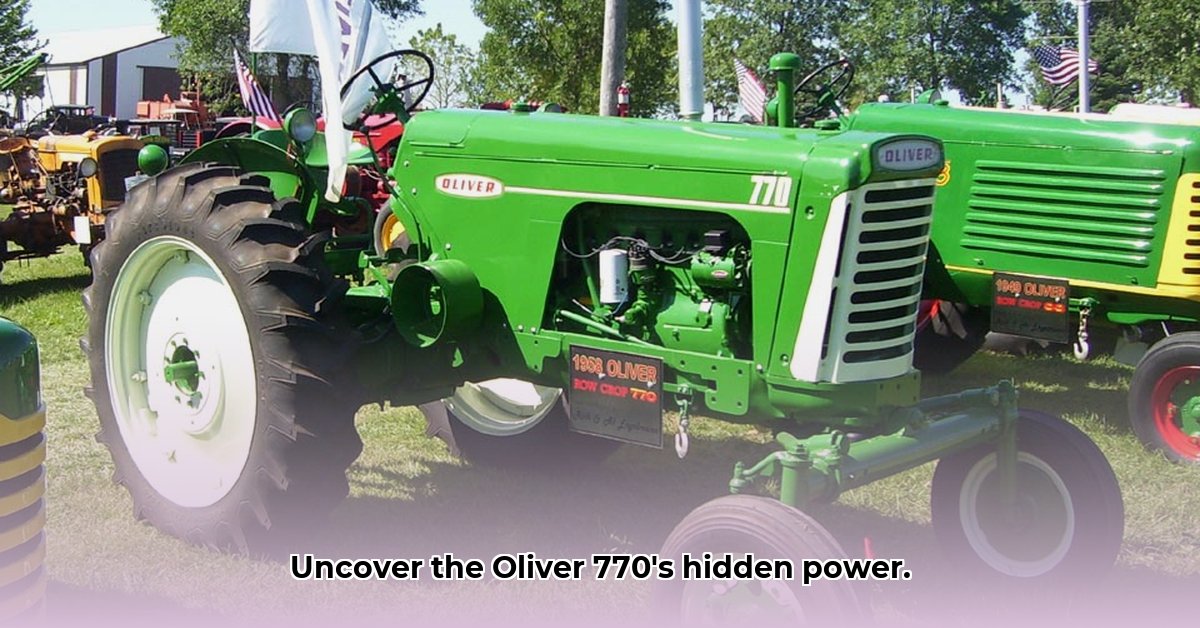
The Oliver 770 tractor, a stalwart of mid-20th-century agriculture, remains a captivating machine for enthusiasts and historians alike. This comprehensive guide delves into its technical specifications, operational aspects, restoration challenges, and historical significance, providing a complete picture of this iconic workhorse. For comparison, see information on another classic tractor, the John Deere 400.
Technical Specifications: A Detailed Look
The Oliver 770 boasted a robust engine, typically around 3.5 liters in displacement, offering impressive power for its era. Fuel options varied, including gasoline, diesel, and even liquid propane (LP) gas, showcasing its adaptability. The engine generated approximately 47 PTO (Power Take-Off) horsepower—substantial power for fieldwork. Its approximate weight of 5500 pounds underscored its sturdy build, designed for heavy-duty tasks and long-lasting durability. Transmission options included a 6-speed sliding gear setup and a more advanced 12-speed Power-Booster system, providing farmers with versatility to match their needs.
Slight variations in reported specifications across historical records likely stem from factors such as manufacturing year, differing measurement methods, and potential record-keeping inconsistencies. However, these minor discrepancies do not detract from the core strength and adaptability of the Oliver 770. This variability highlights the evolution of the model over its production years.
Variants and Applications: Adapting to Farmers' Needs
Oliver recognized the diversity of farming operations. The 770 was offered in several variants to optimize performance for specific tasks:
- Standard Model: A versatile option suitable for general row-crop farming.
- Wheatland Model: Optimized for efficient wheat harvesting, likely incorporating features such as specialized ground clearance.
- High-Crop Model: Designed with increased ground clearance for taller crops.
- Orchard Model: A highly maneuverable model ideally suited for navigating the tight spaces of orchards and vineyards.
This adaptability cemented the 770's popularity among farmers with diverse operations.
Operational Aspects: A Farmer's Perspective
Operating an Oliver 770 was a hands-on experience, requiring skill and experience. Unlike modern tractors, it lacked power steering and air conditioning—features reflecting the technology and priorities of its time: simplicity, robust durability, and maximum power output. The open operator station connected the operator intimately with the machine, a stark contrast to today's climate-controlled cabs. This direct engagement demanded a high level of proficiency and provided a rewarding sense of connection to the work. The 770's straightforward design promised reliability and robust power delivery, exceeding expectations for its time. Wouldn't it be interesting to compare the operator experience between the 770 and a modern tractor?
Restoration and Maintenance: Challenges and Rewards
Restoring an Oliver 770 is a rewarding yet challenging endeavor that tests mechanical skills and historical preservation techniques. However, it's important to recognize the hurdles involved. Part availability poses a significant challenge, often necessitating searching for NOS parts or exploring aftermarket options. Common problem areas include the engine, transmission, and the open operator station's vulnerability to weather conditions. Diligent maintenance prevents costly issues and preserves the tractor's value.
Risk Assessment Matrix:
| Component | Risk Level | Mitigation Strategy |
|---|---|---|
| Waukesha-Oliver Engine | Medium | Regular maintenance, expert rebuild if necessary. |
| Mechanical Transmission | Medium | Frequent servicing; professional inspection highly recommended. |
| Open Operator Station | High | Protective coverings; diligent adherence to safety protocols. |
| Parts Availability | High | Network with restoration communities; consider aftermarket alternatives. |
Historical Context: A Legacy Forged in Time
The Oliver 770's production years (approximately 1958-1967) coincided with significant agricultural mechanization in the United States. Its balance of power, adaptability, and cost-effectiveness made it highly accessible to many farmers. The 770 played a pivotal role in shaping the agricultural landscape of that era, symbolizing innovation and efficiency. Its enduring popularity speaks to its quality and lasting impact on farming practices. How did the 770's design influence subsequent tractor models?
Regulatory Implications: Modern Considerations
The Oliver 770 predates current safety and environmental standards. Operating it requires understanding and complying with local regulations regarding noise levels, emissions (depending on fuel type), and safe operating practices. Prioritizing safety is paramount, given its power and age.
Conclusion: An Enduring Legacy
The Oliver 770's story transcends its function as a farm tractor. It embodies a specific era in agricultural history and exemplifies American ingenuity. Its robust design, versatility, and enduring legacy continue to resonate with enthusiasts, collectors, and anyone who appreciates the rich history of farming. The 770's continued presence in restoration projects and online forums is clear testament to its lasting impact on the landscape of agricultural equipment. The Oliver 770: a machine that endures.